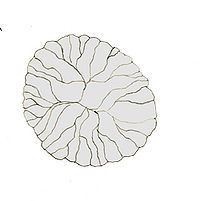Rank Genus | ||
 | ||
Similar Albumares, Anfesta stankovskii, Praecambridium, Ovatoscutum, Tribrachidium | ||
Rugoconites is a fossil member of the Ediacaran biota that takes the form of a circular to oval impression preserved in high relief, six or more centimeters in diameter. The fossils are surrounded by frills that have been interpreted (Wade 1972) as sets of tentacles. The bifurcating radial ribs, spreading from a central dome, serve to distinguish this genus from Paleophragmodictya, and may represent the channels of the gastrovascular system (Fedonkin & Cope 1985). Fossils of Rugoconites have been interpreted as early sponges (Gehling 1996) although this is countered by Sepkoski et al. (2002), who interpreted the organism as a free-swimming jellyfish-like cnidarian; similar to Ovatoscutum. However, the fossil is consistently preserved as a neat circular form and its general morphology does not vary, therefore a benthic and perhaps slow-moving or sessile lifestyle is more likely. Ivantstov & Fedonkin (2002), suggest that Rugoconites may possess tri-radial symmetry and be a member of the Trilobozoa.
Rugoconites have been reported in clusters; this may represent a social/colonial way of life, or simply accumulation by the action of currents, sea-floor processes, or possibly preservational conditions (Droser 2007).
